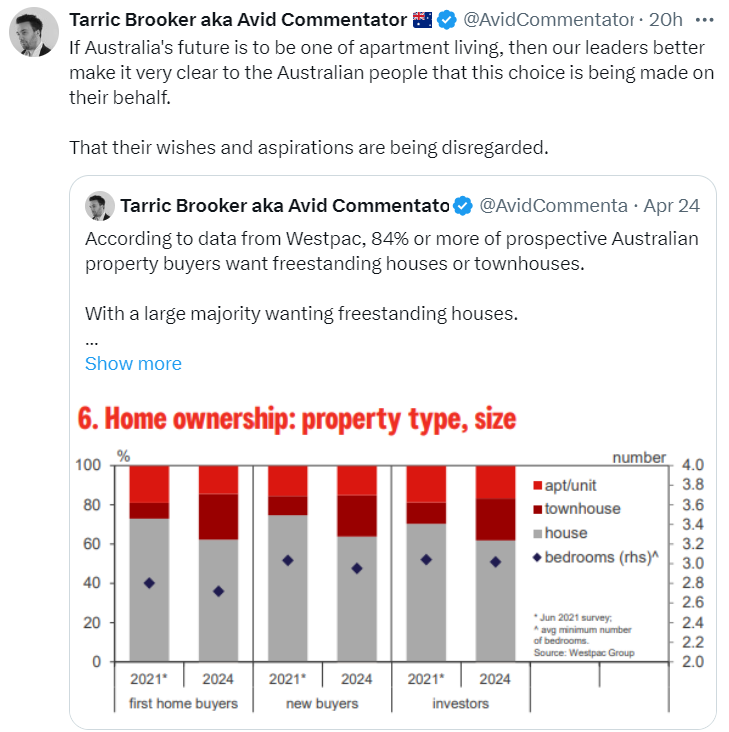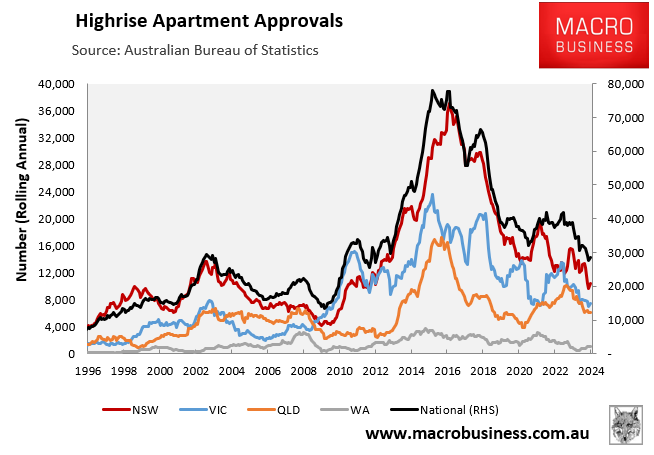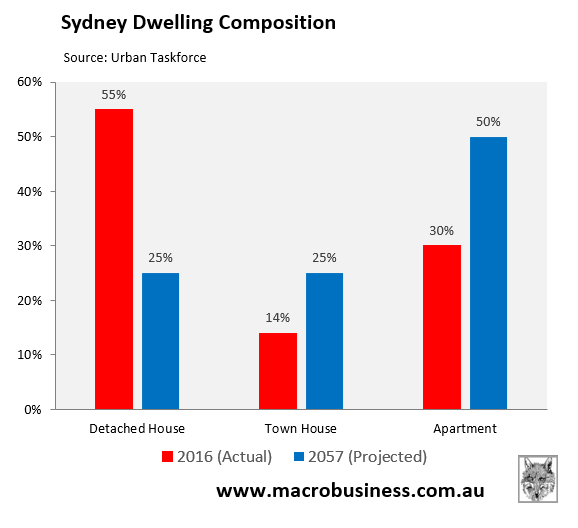Last week, the NSW Productivity Equality Commission released its final report on housing supply challenges and policy options, which touted higher towers, smaller homes, and fewer car spaces as the solution to the state’s housing crisis:

As reported by The ABC:
“Higher-density zones around train stations would double in size… The NSW productivity commissioner is also recommending design standards be relaxed to allow the construction of smaller apartments without access to parking, storage or direct sunlight”…
“The commission has also recommended minimum apartment size requirements be removed, to improve feasibility for developers and affordability for buyers”.
“Balcony size rules, storage requirements, and guidelines for “family-sized” units were also unnecessary, the commission found”.
The NSW Productivity Commission’s recommendations flew in the face of a survey from Westpac in April, which showed that 84% of prospective Australian property buyers wanted freestanding houses or townhouses:

Over the weekend, on Radio 2 GB, I lambasted the NSW Productivity Commission’s report, the highlights of which are presented below.
Edited Transcript:
Earlier this year, the NSW Productivity Commission released a report complaining that Sydney was suffering from a brain drain, whereby people in the of 30 to 40 age group bracket were leaving because of the high cost of housing.
This week, the NSW Productivity Commission released its review of housing Supply choices, which called on state and federal governments to stop spending money on infrastructure to free up construction to build more homes.
To me, this is robbing Peter to pay Paul. As we know, Sydney and Australia more generally are experiencing unbelievable population growth.
At the turn of the century, Sydney had 4 million people. It took you 212 years to get there.
Sydney has now added roughly 1.5 million people this century, and by about 2060, the city is projected to grow to about 8 million people.
So, that means that in about 60 years, Sydney would have doubled its population, which is just an insane amount of growth.
Obviously, if we are going to keep growing like a science experiment through high immigration, we are going to need more housing and more infrastructure.
However, the New South Wales Productivity Commission’s brainiac idea is to stop spending on infrastructure and just divert it to housing. Well, that’s just substituting one problem for another.
The more disturbing thing is that the NSW Productivity Commission also called for more deregulation of housing Supply to allow for higher towers, smaller apartments, getting rid of minimum apartment sizes, fewer car spaces, less natural light, less storage, etc.
The NSW Productivity Commission said that these sorts of reforms could bring down rents by 10%. So, we are talking about a 10% reduction in rent for about 100% reduction in amenity and liveability.
They basically want to shoehorn future Sydneysiders into high-rise dog boxes that are way smaller, have a lack of natural light, have no car parking, smaller balconies, less storage, etc, to solve a problem that is really excessive population growth.
NSW’s population grew by 185,000 last year, 100% of this growth was from immigration.

Instead of going down this high-rise dogbox future of slums, why won’t the Productivity Commission call for sensible levels of immigration so that we don’t have to go down this future?
Let’s also remember that the 2015 to 2019 apartment boom, which saw apartments go up left, right and centre across Sydney, were a very poor standard.

We saw the Opal Towers, the Mascot Towers, a whole bunch of others. It is estimated that half of all high-rise towers that have gone up recently have had major faults.
Does NSW Productivity Commission and the NSW government want to keep going down this road and repeating the same mistakes that happened in the second half of last decade, whereby thousands of very poorly built apartments were slapped up across Sydney and elsewhere? These apartments were incredibly poor poor quality.
The NSW Productivity Commission is symptomatic of what is wrong with government in this country and the bureaucracy.
Instead of addressing the underlying cause, which is excessive population growth that has necessitated housing being constructed very quickly and cheaply and of poor quality, they want to do these sorts of Band-Aid measures to try and push out more supply, which is actually a lot worse quality.
It is going to lead to lower living standards long term. Is this what we want?
In the 2016 Census 55% of Sydney’s dwellings were detached houses with backyards. According to the Urban Taskforce, by 2057, half of Sydney’s dwellings will be apartments and only 25% will be houses.

This represents a complete transformation of Sydney’s dwelling structure from mostly detached houses to much higher high density.
And based on this NSW Productivity Commission report, it is going to be very tiny, shoe box high density, with a lack of natural light, no car parks, small balconies, hardly any storage, etc.
This is a real dilution of our standard of living in Sydney. And this is all so Sydney can grow from 4 million at the turn of the century to 8 million by 2060.
Why are we going down this path?

